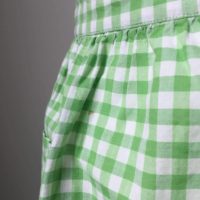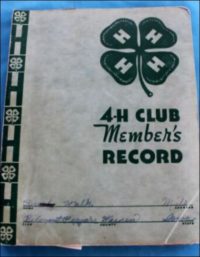By Julie Musick Hillgrove
The sewing machine moved quickly along the fabric as I constructed my first year 4-H project at the Home Economics room at Yorktown School in the mid-1960’s.
“I hear someone who needs a speeding ticket”, yelled the instructor. Of course, she meant me—the 10-year-old, heavy-footed, sewing speedster, who just wanted the project done.

The project was a simple, green and white-checked apron. Unable to keep the machine stitching perfectly straight stiches, I was asked to sew, rip out the seam, sew it again, rip out the seam, etc. Making the apron didn’t seem very fun at all! At some point the instructor let my less-than-perfect-seam pass because the cheap gingham was barely holding together.
My experience wasn’t unique; the apron was often a child’s first sewing project.
My mother-in-law, Donna Nelson Franklin of Daleville, always wore an apron. She used it to carry “a mess” of green beans from the garden or use its edge as a potholder to grab steaming hot pans. She was the iconic homemaker of the 1940s and 50s. On her, the apron symbolized mother and family. I never saw her in the kitchen without it.
Conversely, my mother, Rosie Meyer Musick, had beautiful, stylish aprons, many acquired through “serving” in weddings. Those aprons from the 60’s were see-through, giving the illusion of wearing an apron without really being an apron.
I learned that the mighty apron could serve many purposes. From Crete’s fertility goddess to the jeweled aprons of Egyptian pharaohs, aprons have been the attire of the religious and the mighty. By the Middle Ages, tradesmen and artisans joined homemakers in wearing aprons. Barbers, butchers, stonemasons, gardeners, butlers—all had their own distinctive aprons that indicated their trade or status. During Bacon’s Rebellion (Virginia 1675-1676), Nathaniel Bacon rounded up the wives of his opposition and had them stand with their white aprons around his men as they dug trenches around the heavily fortified Jamestown. Women were too valuable to the fledgling colony to risk injury. The apron defense worked!
By the time I sewed my little apron in the 1960s, the apron was something grandmother wore. After I baked my 4-H cookies that year, I railed against wearing an apron, especially the green and white-checked one. My aspirations did not include being a homemaker.

Times change. I now wear a black-bibbed apron in my art studio every day, my logo prominent in the center. There are 50 identical aprons for use when I teach art—so no excuses. I confess that I spend an extraordinary amount of time every day looking for my cell phone, so the apron has become a handy place to keep it safe. As I’m looking for said phone, I often forget it’s in my apron pocket. Only once did I take the cell phone from my apron pocket and use its flashlight to look for my cell phone.
Today, the apron is back in vogue, even for me. During this pandemic, people have returned to the kitchen. Millennials want aprons that speak to their individuality. Although I struggled to sew cheap, checkered gingham fabric into a less-than-perfect apron, the experience did not discourage my eventual love of sewing. I have sewn many aprons as gifts. My sewing machine still races along but I rarely rip out a seam. Sewing perfectly is overrated!